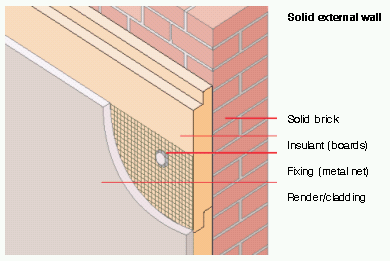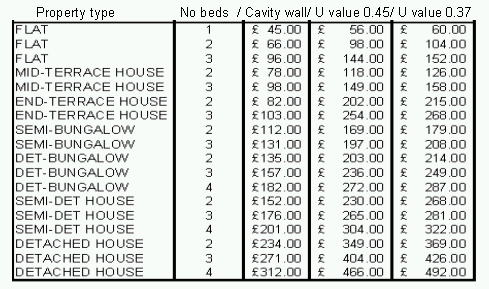| |
Solid
wall insulation (SWI) |
|
What
is solid wall insulation?
Houses built before 1930 and some in later years typically have solid masonry
walls. Heat loss through the external walls is on average 35%. Solid wall
insulation is a way of preventing energy waste and cutting up to 25% of the
fuel bills. In addition to its weatherproofing benefits, where the building
fabric of older houses is in a poor state of repair, solid wall insulation
can deal with both the structural and aesthetic issues.
 |
Solid
wall insulation is generally a composite system made up of three basic
layers - an insulant, a fixing, and a protective, decorative finish.
The two main types of solid wall insulation are external
and internal. The typical U-values of 2.10 W/m2K can
be reduced up to 0.30 W/m2K.
|
External wall insulation
The design and installation of external wall insulation is a specialist job.
It is strongly recommended to use certified materials and components. The
typical method includes attaching standard size insulation boards to the wall
and finishing with a reinforced render or cladding. The boards are between
40-90 mm thick, fixed to the wall with adhesive and mechanical fixings. The
total thickness of the insulation is 50mm to 150mm. For most cost-effective
results this should be done as part of other renovation work.
Internal
wall insulation
Also referred to as dry-lining, this type of insulation involves applying
a 25-50 mm insulation layer on the inside of external walls covered with plasterboard
fixed with adhesive and possibly metal fasteners. The thickness is 40mm -100mm.
-
External insulation requires a planning permission since
it changes the appearance of a house. This is particularly relevant in
conservation areas. You should call your local council to check on local
policy.
-
Internal
insulation does not require a planning permission.
-
External
solid wall insulation -The cost of insulated render/cladding
is around £45 to £65 per square metre, depending on the selected
product, installer, the condition of the exterior surface and its complexity.
Since the whole house needs to be insulated using this method, minimum costs
start around £2000. A typical semi-detached house with some 80 m2
of walls is likely to cost between £3,500 and £5,500.
-
Internal solid wall insulation - to insulate a whole
3-bedroom semi-detached house would cost approximately £650 if done
by a professional or £450 if done as a DIY job. Prices vary by product
and installer.
-
External solid wall insulation - typical annual savings
are between £85 and £120 on the fuel bills. Payback period is
12+ years with an installation life of 25-30 years.
-
Internal
solid wall insulation - typical annual savings are between £75
and £100 on the fuel bills. Payback period is 3 years for DIY installations
and 6-7 years for professional installations.
Grants
The Oxford Solar Initiative (OSI) has secured financial incentives for properties
in Oxford:
The following fixed grants are available for both internal and external type
of solid wall insulation through London Energy:

The
figures are based on gas central heated properties. The grant will depend on
the U value achieved.
Additionally
the Oxford Solar Initiative offers £500 cash back for
any full property external solid wall insulation
| Installation
- External
wall insulation - it is preferable to employ an approved
installer in order to ensure professional work especially in the detailing
(finishing around external services, pipework, windows, etc.). Insulated
render and cladding systems can be applied on average in about three
working days. Because it is applied to the outside of external walls,
there is less disturbance to the household in the process.
- Internal
wall insulation - can be done either using a qualified
installer or as a DIY job. Only part of the house can be done at one
time. Nevertheless, comfort in the chosen rooms is very likely to be
disturbed and therefore it is best to coordinate with a redecorating
job.
|
|
What
are the benefits of solid wall insulation?
-
Reduces your energy bills by up to 25%
-
Improves the thermal comfort in the home and serves as a noise barrier
-
Increases fire resistance of the walls as well as their moisture resistance
-
Reduces carbon dioxide emissions causing pollution and climate change
Further
information on products and installers:
- Insulated Render and Cladding Association (INCA) Ltd., Surrey, tel: 01428
654011; fax: 01428 651401; web site: www.inca-ltd.org.uk
- Celotex Litd., Suffolk, tel: 01473 822 093; fax: 01473 820 880; web site:
www.celotex.co.uk
- PermaRock Products Ltd., Leicestershire; tel: 01509 262924; fax: 01509 230063;
web site: www.permarock.com
Return
to top



